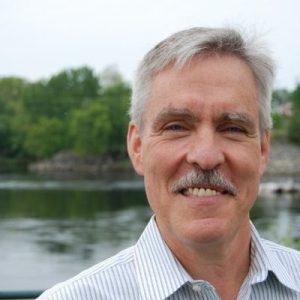A Career in Conservation: Frequent retooling required!
By Nate Poole
The former president of MCHT describes the necessary skillset for a successful conservationist and explores how it has changed over his decades-spanning career
If you’ve ever walked your dog at a local land trust or experienced the splendor of Maine’s coast via dirt single-track, there are good odds that those trails wind their way back to Tim Glidden.
A career Maine conservationist, Glidden most recently completed a decade-long run as the President of the Maine Coast Heritage Trust (MCHT). He also helped zone Maine’s unorganized territory, served as an analyst for Natural Resources Committee at the Maine Legislature, and led the state’s Land for Maine’s Future (LMF) Program.. On February 13, in a talk hosted by the Senator George J. Mitchell Center for Sustainability Solutions, Glidden discussed what he’s learned over the course of fifty years, and how he has had to re-tool his skillset as the landscape of conservation, both political and literal, changed around him.
“Each generation faces some unique challenges, as well as some common challenges, all of which require dedicated and innovative leaders,” Mitchell Center Director David Hart said during his opening remarks. “Tim has taken on many important leadership roles in his career … and I know that the current generation of students and graduates here at the University of Maine are doing the same.”
Glidden could not have become a conservation leader without making the effort to adapt his approach to environmental problems as times changed, but he noted that his success also has plenty to do with luck.
“The story of my career has been one of serendipity. Wonderful things have come along at the right time. Staying open to that is an important part of a successful and rewarding career,” he said.
 An eclectic education
An eclectic education
Glidden holds a bachelor’s degree in environmental studies from Colby College and a master’s degree in forestry from Yale; while not uncommon areas of study by current standards, Glidden had the advantage of building a decidedly uncommon curriculum.
He enrolled in the Environmental Studies program at Colby in 1971, the year after the major was created, and he conducted his graduate studies just as Yale was overhauling the Forestry program to permit more flexibility. As a result, Glidden was able to enroll in the same courses as economics and law students; this unconventional education broadened his intellectual horizons and challenged him to communicate across disciplines. At the same time, he took the opportunity to challenge his professors, stumping economics scholars as he asked them to quantify the value of an endangered species in a cost-benefit analysis. Questions like these helped him understand the limitations of other disciplines, as well as those of his own.
“When opportunities present themselves to step off the conventional track, take a few. Diversify your perspective. Enrich your skillsets by learning how other disciplines approach the world,” he said. “Take some risks; don’t be afraid to jump into a topic in which you may be underequipped. You may … learn that you actually have something to offer others who have been trained to see the world in very different ways.”
Glidden’s interdisciplinary education came in handy in 1984, when he was hired by Maine’s Office of Policy and Legal Analysis to staff the state legislature’s energy and natural resources committee. He supported a working group of legislators tasked with overhauling Maine’s water quality classification and regulatory system, bringing it into compliance with the federal Clean Water Act. His job was to be a neutral communicator, listening to competing arguments, seeking objective and accurate information, and sorting through pros and cons of different options. While his expertise was in forestry, not water quality, Glidden’s lack of prior knowledge was a blessing. He said that a key factor when working with policymakers is trust, and the representatives on the committee trusted him because he was a generalist; he knew enough to communicate the information accurately, but not so much that he approached subjects with preconceived notions or motivations.
This experience with the legislature taught Glidden another valuable lesson: trust and personal integrity are necessary and precious resources in the process of collaboration with decision-makers.
“Simply put, they trusted that I was telling them everything I had learned about the topic, from testimony and research, and that I had no dog in this fight. If they trusted me, I could be useful. If I lost their trust, I was done.”
 Grounded Expertise
Grounded Expertise
Glidden learned another important lesson about creating conservation policy when he worked at the Natural Resources Council of Maine (NRCM); namely, that regulations alone cannot always get you there from here.
In 1997, a hotly contested decision over the fate of Maine’s 17-million-acre North Woods was decided by a state referendum. Developed as an alternative to a referendum to ban clearcutting outright, “The Compact for Maine’s Forests”, was developed as a compromise between environmentalists, including NRCM and Maine Audubon, and major industrial North Woods landowners with the purpose of limiting how much timber foresters would be permitted to clearcut as well as the total timber that a landowner could harvest annually. Supporters claimed the compact would represent a major step forward in promoting the sustainable management of Maine’s forests, while opponents argued that it would do just the opposite and effectively enshrine industrial clearcutting in state law. The Forest Compact was ultimately rejected by Maine’s voters.
Glidden said that years after the failure of the compact, he had dinner with a former executive at Georgia Pacific, then a major North Woods landowner. The executive told him that while the regulatory measures were never passed, many of the corporations took the referendum as a clear warning from Maine’s citizens and revised their forest practices themselves.
“Despite the political failure of the compact at the ballot box, the major landowners learned that Maine’s citizens cared a lot about their forests and even if they weren’t wild about the solutions they were being presented, they were really not happy with the status quo,” he said.
Through the Forest Compact saga, Glidden not only learned that he had little taste or affinity for the conflict inherent in the field of political advocacy, but that they were limits to what could be accomplished with a strictly regulatory approach. Especially in a state like Maine, successful policies need to coincide with the grassroots, ground-level efforts of private citizens.
“Some complex problems are best solved by harnessing the creativity of people working on the ground, in the field, applying and adopting their expertise to widely varying conditions across a landscape,” he said.
A small place in the cosmos
Raised Episcopalian, Glidden struggled during his upbringing with the doctrine of dominion over the natural world that seemed to be a foundational concept in western religion. Initially, he settled into an attitude of stewardship, that humanity ought to be responsible for managing and protecting, rather than dominating, the natural world around it. However, he eventually decided that even that philosophy ultimately seemed to be built on erroneous assumptions.
“How could I, or any human, have sufficient knowledge of this complex, mysterious, and wonderful world necessary to steward all of creation,” he said. “The more I thought about it, the smaller my place in the cosmos seemed and the more humility seemed warranted.”
Glidden found ready application for this attitude of humility and the practical lessons from his career as he began to lead land conservation efforts with LMF and MCHT. He approached this stage of his career with several key principles: 1) Land conservation can be an effective complement to environmental regulation; 2) Little can be accomplished without the trust and buy-in of community members; and 3) Conservation demands strategic, comprehensive planning as well as robust partnerships.
These lessons have yielded much success for organizations like MCHT, having helped to increase the amount of conserved land in Maine from 5% in the ‘80s to more than 20% today. Even more impressive than the numbers have been strategic efforts like the Bagaduce Fishways Project. Over five years, MCHT collaborated with community members and organizations like the Penobscot Alewife Committee to reconnect the waterways on the Blue Hill Peninsula by using the Bagaduce River as a uniting artery. Today, every obstruction in every significant waterway in the region has been removed or bypassed, creating the first fully-restored fish passage in Maine.
“Gone are the days when a land trust can quietly just buy a nice piece of land and then try to keep it a secret, locked away. Community well-being and ecological well-being are clearly intertwined. The successful land conservationist today is listening to understand community needs as much as they are out there trying to study wildlife.”
While he is now a year into retirement, Glidden will remain involved in ongoing conservation and sustainability efforts in Maine, including his role as a newly-appointed member of the Mitchell Center’s Advisory Board. While the future is as uncertain as ever, Glidden’s adaptability and humility are sure to remain constants.
###
For nearly a decade, the Mitchell Center has hosted its Sustainability Talks series during the fall and spring semesters, providing students, faculty, citizens, and others in and outside of the University of Maine community with opportunities to learn about the multi-faceted nature of sustainability problems from the researchers, professionals, representatives, and every-day people finding innovative ways to address them. Recordings of past talks are available online.

